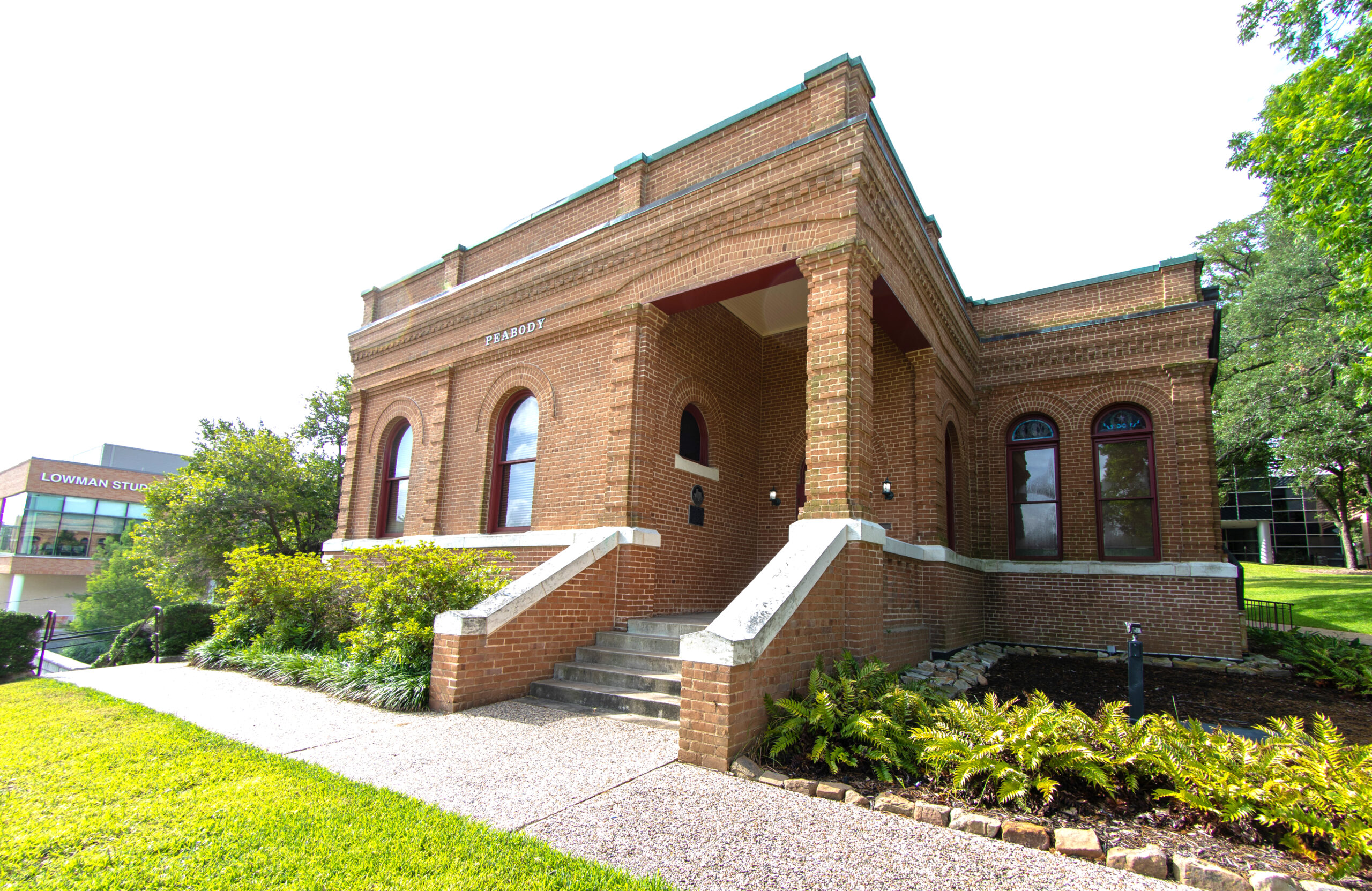
It wasn’t until 1928, when an increase of students caused Peabody to run out of library space, that the library moved to a bigger building called Estill. It remained an office for professors, along with C.R. Hackney putting it into service as a band hall until 1951 (the building still has remnants of the bluish-grey tiles that often flooded when the rain came down the hill), when it became a foreign language office. The broadcasting studio for KSAM, the Huntsville radio station, was in the building for a period, starting in 1939; during 1979-1982, the radio, television, and film departments and KSHU-FM used Peabody as studio space (electrical plugs can still be seem in the basement). 1942 had the Student Army Training Camp for World War II Military Officers office located in Peabody.
From 1954-1979, Peabody became a dance studio, ROTC storage space in the basement, and even a bomb shelter during the Cold War. After the Board of Regents stopped a razing of Peabody in 1981, it became part of a State Archeological Landmark February 18, 1982—the same year Old Man burned down—and a Texas Historic Landmark in 1990, after a $1.5-million renovation the previous year.
The last fulltime use of Peabody Memorial Library was the University Archives between 1991-2004. The first University Archivist was Linda Fowler, the second is Barbara Kievit-Mason who has remained in this position for 25 years. Humidity and mold issues moved the archives to the Newton Gresham Library, the current library for Sam Houston State University.
While Peabody has been many things to many people over the years, it’s not completely abandoned and can be used for formal reception, meeting, and other events for the university president’s cabinet. Students of the university are not permitted to go inside the building and often wonder what is within the building’s walls. The basement, especially, is inaccessible to anyone who goes in the building.
When people get the opportunity to go inside Peabody, they might discover an empty room, if there are not event tables set-up. But to the right of the door remains the 1894 M.P. Moller opus 139 pipe organ, the oldest artifact on campus, that once was in Old Main, and was placed in Peabody August 3, 2007. While this magnificent instrument is preserved inside the building, it’s unplayable due to parts needing refurbishing. According to Barbara Kievit-Mason, playing the organ is worrisome for the original stain-glassed windows and the Old Main window being shattered.
There is one remaining 11 foot by 4 foot table inside the building that was used for studying when Peabody was a library. When looking at the table, there are three small holes on the top which were used for lamps.
The original stained-glass window to the right of the front door once belonged in Old Main. It was saved during the 1982 fire due to it being in the building’s basement. When looking at the window in Peabody, you may not notice, but there was a mistake when putting it up (it’s upside down; the circles at the bottom of the window are supposed to be at the top).
Over a dozen classical and literary figurehead busts can be found along the walls in the Reading Room; writers like Dante and Tolstoy, composers like Tchaikovsky and Wagner, even the Roman/Greek goddess Diana/Artemis. Most of these figures are about the size of a coffee pot, but larger bust figures of the philosophers Diogenes and Socrates (which are three times bigger) are found on the fireplace mantle.
During Peabody’s 1992 renovation, the fireplace was rebuilt. Additions to the renovations also include bathrooms (that once were a cloakroom), a back staircase, small attic area, an alcove, chandeliers, and shelving underneath the windows throughout the front of the building. Behind the organ is a wooden wall that was also added to hide file and map cabinets when the university archives were still located in the building.
The 30-foot ceiling of Peabody is still the original metal tin design that was saved by the radio, television, and film department between 1979-1981. The department installed a drop ceiling, or suspended ceiling, which was used to hide Peabody’s infrastructure. In every room, including the bathrooms, the metal tiles have different patterns. There are remnants of a library ladder system, which is a giant square around the stacks, in the room with the organ.
There are three colors on the interior—grey(ish), tan, and white—that are difficult to get and can’t be matched anymore due to the specific pigment required for the walls.
When people have the chance to walk through the red front door, they might notice two particular differences not found in modern-day doors. First, the metal door handle is the original. Second, the size of the door is wider than a standard one-door entrance—this was used to accommodate the hoopskirts of the day.
When looking outside the building, there is a distinctive dome on top that is 30 feet high. When the University Archive was still in Peabody, Barbara Kievit-Mason shared her experience of squirrels running across the dome’s top; the dome’s acoustic sound makes the squirrels echo throughout the building, especially in a room with minimal objects.
There was once an 8-foot statue of the Greek goddess Athena that was placed in Peabody’s reading room in 1997, until the University Archives moved to Newton Gresham Library in 2004. The statue was originally placed in an alcove located in Old Main in 1922—it was a class gift in 1912. But between stays in Old Main and Peabody, the statue was moved to the Estill building in 1928 (when it was still a library), where it was forgotten in an art studio until 1997. After Peabody, the statue moved back to the art department, where it remains today.
The Peabody Memorial Library has a rich history at Sam Houston State University and remains timeless. For students who pass the building, they often are unaware of its significance or simply curious as to its purpose. But those able to walk around the interior during special occasions are able to see the beauty of the metal titles, the vast organ, and try to guess the figureheads around the room. The Peabody Memorial Library is truly a historical treasure for Sam Houston State University.

Postcards Magazine
936-293-1188
PO Box 690
Huntsville, TX 77342
